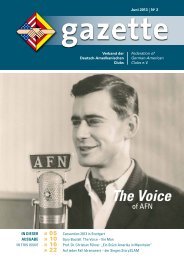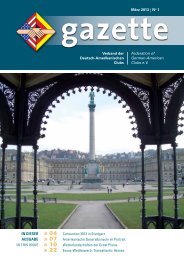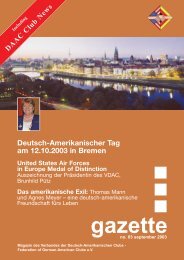.gazette 02/03 - Verband der Deutsch-Amerikanischen Clubs e.V.
.gazette 02/03 - Verband der Deutsch-Amerikanischen Clubs e.V.
.gazette 02/03 - Verband der Deutsch-Amerikanischen Clubs e.V.
Erfolgreiche ePaper selbst erstellen
Machen Sie aus Ihren PDF Publikationen ein blätterbares Flipbook mit unserer einzigartigen Google optimierten e-Paper Software.
The American Forces Network<br />
Europe had an extraordinary<br />
beginning, born out of the winds<br />
of war and nurtured into broadcast<br />
history by legions of citizensoldiers.<br />
American Forces Network Europe<br />
started as an idea in the mind of<br />
General Dwight D. (Ike) Eisenhower<br />
more than a year before the<br />
invasion of Europe during World<br />
War Two.<br />
As an experienced military lea<strong>der</strong>,<br />
Ike knew that an informed soldier<br />
would be a better soldier and it<br />
was this basic philosophy that<br />
formed the foundation of his<br />
vision. The General and his staff of<br />
war planners in London also knew<br />
that thousands of American GI’s<br />
who were pouring into Great<br />
Britain and preparing for D-Day<br />
also needed entertainment…<br />
American entertainment.<br />
The Problem<br />
In September General Eisenhower<br />
or<strong>der</strong>ed his staff to quickly find a<br />
way to provide soldiers with information<br />
and entertainment.<br />
General Everett S. Hughes and Mr.<br />
Brewster Morgan at the Office of<br />
War Information called a meeting<br />
and within hours agreed to establish<br />
a magazine, a newspaper<br />
and a radio station. The magazine,<br />
later called “YANK”, was popular<br />
throughout World War II. The newspaper,<br />
which had its roots in<br />
World War One ”THE STARS AND<br />
STRIPES”, continues publication<br />
today.<br />
The radio station that would have<br />
a series of transmitters located<br />
near U.S. soldier camps would be<br />
known as “THE AMERICAN<br />
FORCES NETWORK”.<br />
The Foun<strong>der</strong><br />
Captain John S. Hays was selected<br />
to organize the establishment<br />
of the radio network.<br />
His first goal was to persuade the<br />
BBC to relinquish some of its<br />
monopolistic broadcasting rights.<br />
As an incentive he offered the<br />
BBC exclusive rights to some<br />
popular American radio shows.<br />
After organizing a small office in<br />
London and hiring a secretary,<br />
AMERICAN<br />
FORCES<br />
NETWORK<br />
Sixty Years<br />
and Counting<br />
by Herb Glover, John Provan,<br />
and Roger Williams<br />
Captain Hays began a tedious<br />
search through military personnel<br />
records. He uncovered the names<br />
of 12 civilian broadcasters in uniform<br />
already in England. They were<br />
transferred to AFN, and with the<br />
help of the U.S. State Department,<br />
Captain Hays obtained studio space<br />
at 11 Carlos Place in London.<br />
Hays, like many AFN alumni,<br />
would continue to gain prominence<br />
as a public servant after leaving<br />
the network. He served for a time<br />
as the U.S. Ambassador to Switzerland.<br />
The names of other prominent<br />
Americans appeared on the<br />
uniform roster of early-day AFN<br />
Europe including actors, Bro<strong>der</strong>ick<br />
Crawford and Mickey Rooney<br />
and famed Hollywood movie<br />
director, Josh Logan, to name a<br />
few.<br />
Born On the 4th of July<br />
It is not by accident that AFN<br />
transmitters were activated on a<br />
U.S. Independence Day.<br />
It is somehow appropriate that the<br />
soldier network would begin to<br />
broadcast on America’s most<br />
patriotic annual observance. At<br />
5:45 on the afternoon of the 4th<br />
of July, 1943, listeners heard The<br />
National Anthem followed by<br />
introductory remarks by Brewster<br />
Morgan. Then, AFN’s first disc<br />
jockey-announcer, Technical Sergeant<br />
Syl Binkin, began spinning<br />
records and a tradition in military<br />
broadcasting was born.<br />
Forum<br />
The Invasion<br />
By May 1944, 1.7 million U.S. soldiers<br />
were poised in Great Britain<br />
waiting for or<strong>der</strong>s to cross the<br />
English Channel to begin one of<br />
the largest invasion operations in<br />
military history.<br />
D-Day came a month later and<br />
AFN reporters accompanied the<br />
invasion force to broadcast the<br />
soldier’s story, to entertain and to<br />
inform. That same month AFN<br />
studios moved to 80 Portland<br />
Place, closer to BBC headquarters<br />
and further out of range of<br />
German V-1 rockets. By war’s end<br />
some 75 AFN radio transmitters<br />
were operating throughout Great<br />
Britain.<br />
The Programs<br />
The Armed Forces Radio Service<br />
provided much of the radio programming<br />
on 16-inch transcription<br />
discs in the United States.<br />
Among the early programs were<br />
“Mail Call”, “At Ease”, “Sound<br />
Off”, “Hymns From Home”, and<br />
“GI Journal”. One of the most<br />
popular and successful shows<br />
was “Command Performance”. It<br />
was a spectacular wartime variety<br />
show and was prepared for AFN<br />
by top names in the entertainment<br />
industry and transmitted by short<br />
wave from CBS and NBC studios<br />
in the U.S. Famous personalities<br />
donated their talents each week to<br />
the war cause and were requested<br />
by servicemen to appear on this<br />
show.<br />
The War Ends<br />
By war’s end, AFN began reconstituting<br />
itself on the European<br />
continent, with transmitters and<br />
studios located in Antwerp,<br />
Biarritz, Bremen, Berlin, Chamberry,<br />
Cannes, Frankfurt, Kassel,<br />
Le Harve, Linz, Lyons, Nancy,<br />
Nice, Nuremberg, Marseilles,<br />
Munich, Paris, Port de Bouc,<br />
Reims, Rome, Salzburg and<br />
Stuttgart.<br />
Several of the mobile units eventually<br />
were used to help establish<br />
the AFN network in Germany.<br />
The most memorable early stations<br />
and networks were BLUE<br />
DANUBE NETWORK (BDN) in<br />
Austria and Southern European.<br />
15









